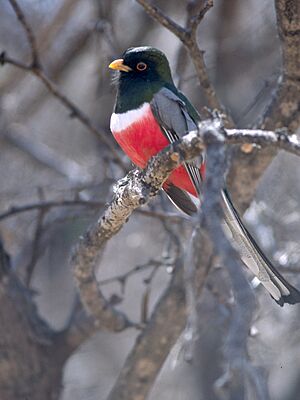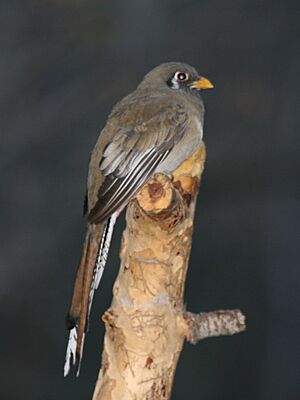Elegant trogon facts for kids
Quick facts for kids Elegant trogon |
|
|---|---|
 |
|
| Male | |
 |
|
| Female | |
| Conservation status | |
| Scientific classification | |
| Genus: |
Trogon
|
| Species: |
elegans
|
 |
|
| Synonyms | |
|
Trogon ambiguus Gould, 1835 |
|
The elegant trogon (Trogon elegans) is a beautiful bird found in Central America. It used to be called the coppery-tailed trogon. The word "trogon" comes from a Greek word meaning "to gnaw." This describes how these birds make their nests in trees.
Contents
What is an Elegant Trogon?
The elegant trogon is a medium-sized bird. It measures about 28 to 30 centimeters (11-12 inches) long. It usually weighs between 60 and 78 grams (2.1-2.7 ounces).
How They Look
Like many birds, male and female elegant trogons look different. This is called sexual dimorphism.
- Males: They are very colorful. They have a bright red-orange lower chest and belly. Their back is a shiny deep green. Their old name came from the copper color on their backsides. Their face and throat are dark black. A white band goes across their chest. Their upper wings are grey. Their long, square-tipped tail feathers are usually brown on top. The underside of their tail is white with black stripes.
- Females and Young Males: They look similar to each other. They have the same patterns as adult males. However, their colors are much duller, usually brownish-grey. They also have a white ring around their eyes.
Types of Elegant Trogons
Scientists group animals into different types. The elegant trogon has five recognized subspecies. These are like different versions of the same bird.
- T. e. elegans
- T. e. ambiguus
- T. e. canescens
- T. e. goldmani
- T. e. lubricus
Some bird experts think T. e. ambiguus is its own separate species. Other experts disagree.
Where They Live and Their Home
The elegant trogon lives in Central America. You can find them from Guatemala in the south. They go as far north as Arizona and New Mexico in the United States. They are the northernmost type of trogon in the world.
These birds like dry, open woodlands and forests. They prefer areas with pine and oak trees. They also like hillsides near cliffs. They do not like very humid places. In Arizona, they live in canyons with lots of trees like junipers, oaks, and sycamores.
Some trogons in the northern areas move short distances. They usually go north to Arizona for the breeding season.
How They Behave
Elegant trogons often interact with each other. They use calls and tail movements to communicate.
Their Calls
Their usual call sounds like a croaking "co-ah co-ah co-ah." They also make chattering sounds. Male trogons tend to call more often than females. For males, their calls don't change much with the seasons. But females call more during the time they are sitting on their eggs.
Tail Talk
Moving their tail is a way they communicate.
- To other trogons: Raising their tail can show who is in charge. It might also be linked to mating.
- To predators: If they raise their tail when a predator is nearby, it's like an alarm. It tells the predator, "I see you! You might as well give up."
What They Eat
Elegant trogons eat both fruits and insects. This means they are frugivores and insectivores. Their wide bills and weak legs are good for their diet. They eat fruits like grapes, cherries, and figs. They also enjoy insects such as grasshoppers, moths, and beetles. Sometimes, they might even eat small lizards.
They are fast flyers but don't like to fly long distances. They often sit still on a branch. To catch food, they stay still, then quickly fly out to grab an insect or pluck a fruit.
Raising a Family
Elegant trogons build their nests in shallow holes in trees. These holes are usually 2 to 6 meters (6-20 feet) high. They often use old holes made by woodpeckers. They lay two to three eggs. Both parents take turns sitting on the eggs. This lasts about 17 days.
Both male and female trogons care for their young. They both bring food, mostly insects, to their chicks. They continue to feed their young for about a month after they learn to fly. After that, the parents split up the young birds. The male parent takes care of the male young, and the female parent takes care of the female young.
Conservation Status
The elegant trogon is listed as endangered in the state of New Mexico. This is because they need specific habitats, like pine-oak woodlands and water. These areas can be easily disturbed.
However, the IUCN Red List says the elegant trogon is a species of "least concern" as of 2020. This means they are not currently threatened or endangered in most of their habitat. Even though their numbers are slowly going down, they are still doing well overall.


